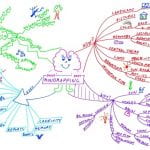 You may already be familiar with mind mapping to plan essays or organise your lecture notes (see also Make your notes more visual). Mind mapping can also help you -individually or with fellow students – to build up a ‘bigger picture’ of complex systems or subjects. Unlike text which is read in a linear sequence, mind maps and diagrams allow a great deal of information to be taken in simultaneously. Mind-maps are also useful as memory aids and tools for revision. A lot of students use mindmapping software but freehand drawing lets you be more flexible and include images more easily. The example here is from a useful resource at https://www.sheffield.ac.uk/ssid/301/study-skills/everyday-skills/mind-mapping
You may already be familiar with mind mapping to plan essays or organise your lecture notes (see also Make your notes more visual). Mind mapping can also help you -individually or with fellow students – to build up a ‘bigger picture’ of complex systems or subjects. Unlike text which is read in a linear sequence, mind maps and diagrams allow a great deal of information to be taken in simultaneously. Mind-maps are also useful as memory aids and tools for revision. A lot of students use mindmapping software but freehand drawing lets you be more flexible and include images more easily. The example here is from a useful resource at https://www.sheffield.ac.uk/ssid/301/study-skills/everyday-skills/mind-mapping
Get into the habit of drawing quick freehand maps to represent all kinds of places or processes or abstract ideas. For example:
- Your journey to uni.
- Your support network of family and friends
- The relationship between different bits of the course
- Your ideas for your next essay
- Try module mapping – choose a current or recent module from the course you are studying Draw a ‘map’ showing main topics, key ideas etc – this could reflect the order in which you studied each area or any other structure that makes sense for you. Using post-its lets you move things around initially Draw/doodle some kind of image for each topic to help make it more memorable
(First posted as part of the University of Brighton Big Draw October 2019)


